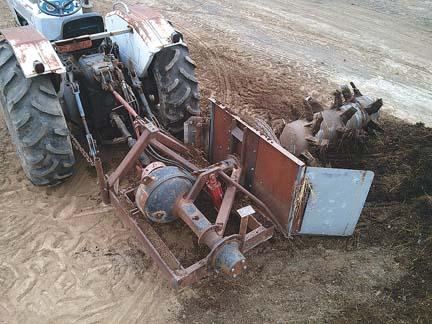
Sonoma grape farmer Paul Bernier of Geyserville, Calif., built a 3-pt. mounted compost turner using a 20,000-lb. truck differential. He uses the compost turner on windrows that are 12 ft. wide, 120 ft. long, and spaced 8 ft. apart.
“It’s a cost-effective way of turning grape compost, or ‘pomace’, which I use to improve the organic matter in the soil around my vineyard,” says Bernier.
“The machine is only 6 1/2 ft. wide so there’s plenty of room to maneuver between windrows. It lets us pack a lot of windrows into a relatively tight space. The windrows are made up of both stems and pomace from a local vineyard press. We’re composting the material into a mixture that breaks down easily and is also easier to apply with a spreader.”
Bernier says he has been making compost for his operation for more than 35 years, in the past turning it with a loader tractor. “The loader did an adequate job, but it was slow and took up a lot of space. I borrowed a friend’s commercial compost turner one year, but I didn’t like the machine’s 7,000-lb. weight or the 100 hp tractor required to operate it.
“I thought if I only turned half the width of the windrow at a time, I might be able to use my 70 hp, 2-WD wheel tractor to pull a much smaller machine. And I’d be saving money. Commercial compost turners sell for about $25,000 or more, whereas I spent only about $1,000. It took me about a month to build.”
He copied the specs of the commercial turner to build his own machine. It’s equipped with a 16-in. dia. drum fitted with 8-in. paddles, which rotate against the direction of travel at about 200 rpm’s.
“I thought a truck differential would do the job of a right angle drive, and found a 20,000-lb. broken axle in a friend’s scrap bin,” says Bernier. “The axle was geared a little low at 5.28:1, but my tractor has a 2-speed pto which results in about 200 rpm’s at the end of the axle. I had to mount the housing upside down to get the correct rotation. I cut off the unneeded axle tube, welded the spider gears to the cage to eliminate differential action, and carefully aligned everything so that it runs true.”
The agitator drum is made from 3/16-in. thick by a length of 16-in. dia. well casing, which Bernier welded to a 10-hole bud wheel center. “I removed the brakes and backing plate from the axle tube, but kept the wheel hub which the agitator drum is fastened to with lug nuts. The agitator is 6 1/2 ft. long so it’ll easily turn a 12-ft. windrow. I go down one side of the windrow, then turn around and come back down the other side.
“I’ve used the machine for 5 years and turned more than 10,000 yards of compost with no problems. Truck rear ends are built tough.”
Bernier used 1/2-in. thick flat stock to build the tines and bolted them onto brackets that are welded to the drum. A home-built angled steel blade runs alongside the tractor to lift up compost material just before it’s turned. A length of truck tire tread bolted to a metal plate serves as a deflector at one end of the drum, to keep material from being thrown back at the driver.
“Anyone with high school shop skills and access to a junkyard could build a compost turner like mine,” notes Bernier.
Contact: FARM SHOW Followup, Paul Bernier, 1720 Canyon Rd., Geyserville, Calif. 95441 (ph 707 849-7620; lreinreb@gmail.com).
1-800-834-9665
“Made It Myself” Truck Axle Composter
FARM SHOW Magazine » “Made It Myself” Truck Axle Composter
“Made It Myself” Truck Axle Composter
